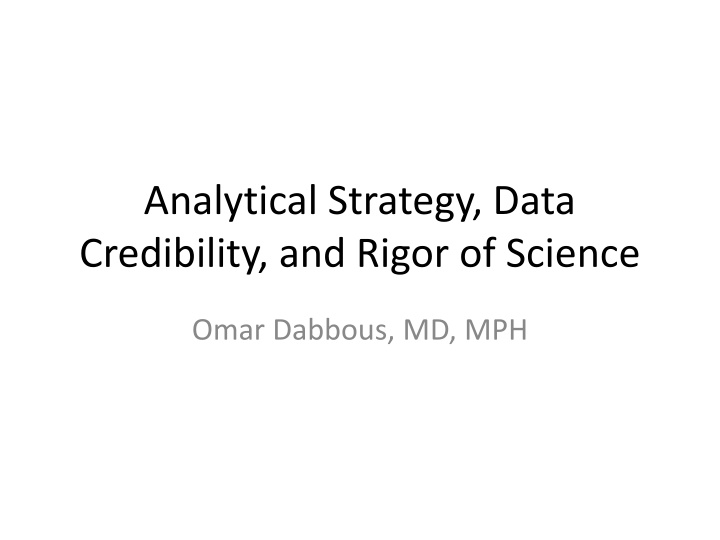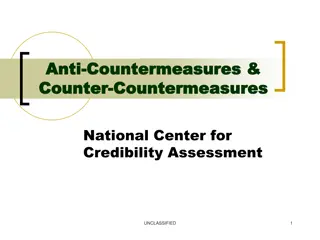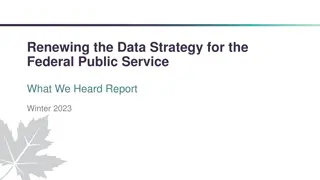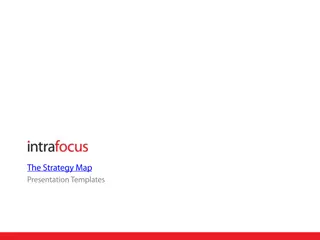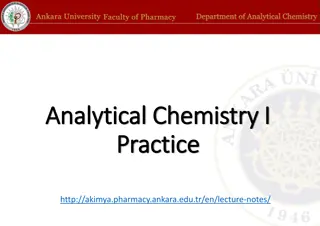Analytical Strategy and Data Credibility in Science
In this resource, Omar Dabbous, MD, MPH explores the analytical strategies, data credibility, and rigor required in scientific research. The content delves into essential aspects of how data is analyzed, interpreted, and upheld for maintaining the credibility and integrity of scientific findings.
Download Presentation

Please find below an Image/Link to download the presentation.
The content on the website is provided AS IS for your information and personal use only. It may not be sold, licensed, or shared on other websites without obtaining consent from the author.If you encounter any issues during the download, it is possible that the publisher has removed the file from their server.
You are allowed to download the files provided on this website for personal or commercial use, subject to the condition that they are used lawfully. All files are the property of their respective owners.
The content on the website is provided AS IS for your information and personal use only. It may not be sold, licensed, or shared on other websites without obtaining consent from the author.
E N D
Presentation Transcript
Analytical Strategy, Data Credibility, and Rigor of Science Omar Dabbous, MD, MPH
Objectives Understand current payer challenges Importance of data rigor and credibility Analytics strategy development
Evolution of Healthcare Decision Making Payers Patients/Society Regulators Economic Cost of Illness Resource Use Cost- effectiveness Budget Impact Humanistic HRQoL Patient Satisfaction Preferences Productivity Clinical Efficacy Safety 1970-80 s 1990-00 s 2010-20 s
Payer Questions Can we afford it? Are we getting the best value for the health care money spent?
Types of Healthcare systems EU Single payer Reference Pricing USA Fragmented Payer environment HMO s CMS (Medicare/Medicaid) VA ACO s
Accountable Care Organization (ACO) Accountable Care Organizations as a new model for care delivery is yet another attempt in the reform process and a step towards transforming the healthcare industry - from the traditional fee for service-based care to care that creates value for patients. Accountable Care Organizations (ACOs) are described as provider groups that accept Responsibility for the cost and quality of care delivered to a specific population of patients cared for by the groups clinicians. ACOs are bringing broad appeal and hope for the future by improving the coordination and quality of care to patients while reducing the rate of increase in health care costs over time- Shortell, etal. 2010
Payer and HTA Dossier Pricing and Burden of illness Reimbursement Clinical / PROs Unmet Needs Cost Models 9
Scientifically robust Value Proposition A Value story is developed bringing together clinical benefits of an intervention and communicating their impact: Relative efficacy, tolerability, administration benefits Humanistic and cost perspective Price and value proposition are inexplicably linked
Value-based Pricing (evidence-based pricing) $ Value-based price Quality of Care Quality of Life Loss of opportunities Cost offsets Safety Efficacy $1 $ Comparator price
Current situation Payers are scrutinising company scientific data (both clinical and HEOR) more than ever. In many cases payers are finding holes considering the real unmet needs that medicines are proposed to fill: Issues with the trial: Statistical powering to show needed reimbursement endpoints Selecting the right comparator Selecting the right measures/outcomes Data from Patient subgroups is usually limited/inadequate: Hardly ever pre-specified for analyses (ad-hoc & not powered) Patients with particular comorbidities are often excluded Not generalizable to real world settings
Expectations: Innovation and sophistication in value research design, analysis, and interpretation Quantitative input into plans, objectives, and projects Rigor of analytics and data: new insights to interpret data and to support acceptable/relevant payer and HTA evidence Do we have the right evidence? Anticipate and innovatively address research questions. Explore what is missing Are we accurately interpreting and communicating the data in a timely fashion? Are we asking the right questions and capturing the right data? Are we using the right study design and sophisticated analytical methodologies as appropriate? Develop and use innovative, validated and accepted methodologies: economics, network meta-analysis, observational studies, etc.
Pharmaceutical Capability Gap Significant capability gaps in key specialist skill areas CT aggregation, interrogation, evaluation, e.g., pt sub-groups Observational study design, analysis, reporting Healthcare Database interrogation Economic model building, evaluation, validation Network meta-analysis CER, HTA Interpretation of data outputs Validation of value/payer dossiers
Guidelines for Quality Observational Studies GRACE principles for observational studies of comparative effectiveness. Am J Man Care 2010;16(6):21-24 ENcEPP Checklist for methodologic studies, 2010. www.encepp.eu ISPOR Good Research Practices for CER I, II, III . Value in Health 2009; 1044-1072 GPP: Guidelines for good pharmacoepidemiology practices Pharmacoepidemiology & Drug Safety 2008:17:200-208 STROBE: Strengthening the Reporting of Observational Studies in Epidemiology, Epidemiology 2007;18(6): 805-835 AHRQ REGISTRIES HANDBOOK: Gliklich RE, Dreyer NA, eds. : Registries for Evaluating Patient Outcomes: A User's Guide. Prepared by Outcome DEcIDE Center. AHRQ Publ. No. 07-EHC001-1. Rockville, MD. 2007. 2nd edition, in press, 2010.
Guidelines for Health Economics A total of 25 guidelines were identified: seven formalized (level of agreement 40% to 100%) eight informal (25% to 100% ) Ten guidelines for HE methods (30% to 100% ) The formal guidelines were slightly more homogenous than the other groups. The between-group comparison showed that the guidelines were in agreement for about 75% of methodological aspects. Disagreement between guidelines was found in choice of perspective, resources, and costs that should be included in the analysis, and in methods of evaluating resources used VALUE IN HEALTH: Volume 4 Number 3 2001
Robust Evidence Innovative study design Clinically relevant Disease/conditions, treatments, comparators, target pop n Measures of effectiveness, safety and tolerability Apply sophisticated analytic methods to proactively address anticipated payers questions: Data collection, including handling of missing data Appropriate methods to address confounding Comparison to patients with similar likelihood of treatment and benefit Consideration of alternative explanations Accurate data interpretation and validation 21
Robust, Credible, and Relevant Evidence Pricing and Burden of illness Reimbursement Clinical / PROs Unmet Needs Cost Models 22
Approach to Develop Robust Evidence Understanding the requirements and the expectations of payers & HTAs is critical for a successful application This would require an analytical strategic scrutiny of HTA decisions to anticipate the methodologies to be mastered and implemented by companies
Definition The analytical strategy is the identification, development and implementation of analytical methodologies that are considered critical success factors to achieve HTA favorable decisions as well as optimal pricing and reimbursement for products pharmaceutical portfolio
Proposed Analytical Strategy Framework Payer Value Evidence for Reimbursement Clinical Efficacy and effectiveness Economics Evidence Patient Benefit 1. Clinical Trial Designs/population/en dpoints 2. Subgroup Analysis 3. Comparative: Relative/Effectiveness 4. NMA (ITC, MTC) 1. Collection/analysis of Cost data 2. CEA using data from clinical trials 3. CEA using decision modeling: (1) data/analysis for parameter input (2) Validation study Design/ Analysis of PRO/QOL/QOC in 1. Clinical trials 2. Observational studies Statistical Methods: Is the data Robust? Relevant? Credible? 2 6
Requirement and expectation from payers & HTA bodies Requirements - described in the decision framework analysis and guidance for applicant. -define the requested information and the acceptable methodology to generate evidences Expectations - not defined in documents and often implicit. - critical for a successful HTA application. When expectation are better formalize they could either be implemented in the decision framework (eg. probabilistic sensitivity analysis NICE) or lead to a guideline (network meta-analysis for HAS)
Payers & HTA Expectations The HTA expectation could be stated in a more or less specific way Example of non specific expectation Example of specific expectation The observational study analysis integrate a propensity scoring to adjust for random sampling but in reality some channeling by indication exist and would required a propensity matching technics to account for population selection bias. The channeling by indication made unlikely that propensity score technic allow for proper adjustment of the selection bias In the first case HTA express their concern and the way forward to address their concern, in the second case they do not provide guidance to address their concern.
Process (1/2) Develop and maintain an up-to-date understanding of methodological analytic requirements from HTA Watch dog on HTA expectations by surveying selected reports in selected countries Deep analysis of HTA reports related to company portfolio to identify expectations specific to the disease area Organizing twice a year a one day HTA expert board to debrief current and future trends in HTA strategic analytic
Process 2/2 Establish non product specific analytic landscape Establish product specific analytic landscape Consolidate the analytic landscape Strategic analytic recommendations Identify the impact of strategic recommendations on the evidence generation and feed Evidence generation team Clinical Outcomes Integration of the analytic strategic considerations in the global evidence development plan
Pharma Business Model: Then and Now We are changing internally, but it is not radical enough. Old Business Model New Business Model Methods R&D go/no-go decisions Safety Efficacy Safety Efficacy Reimbursability/Value Factor analysis and structural equation modeling, principal component analysis, partial least squares regression, analysis of non-experimental data Efficacy Relative efficacy Comparative effectiveness Kaplan-Meier analysis, Cox- survival regression models, mixed effect survival models Price Free pricing Value-based pricing Cost effectiveness standard meta analysis, indirect and mixed treatment comparisons, network meta- analysis, frequentist and Bayesian network meta- analysis 31
Pharma Business Model: Then and Now We are changing internally, but it is not radical enough. Old Business Model New Business Model Methods Reimburseme nt/ Access Open access Restricted access Step therapy Market segmentation Regression techniques: Multiple linear regression, logistic regression, regularization, Bayesian regression, high dimensional data modeling, multi- collinearity problem, generalized linear models, survival models, mixed-effect models Health Economics & Outcomes Research (HEOR) Nice to have No seat on Development team Must have Core member of Development team Payer-focused team Decision trees, influence diagrams, Markov modeling, micro-simulation, discrete event simulation, Bayesian modeling and decision analysis, Bayesian networks Post- marketing studies Efficacy, safety Efficacy, Safety, Effectiveness Comparative effectiveness Validation of value- proposition time varying confounders, counter-factual causal models and marginal structural models structural nested models 32
